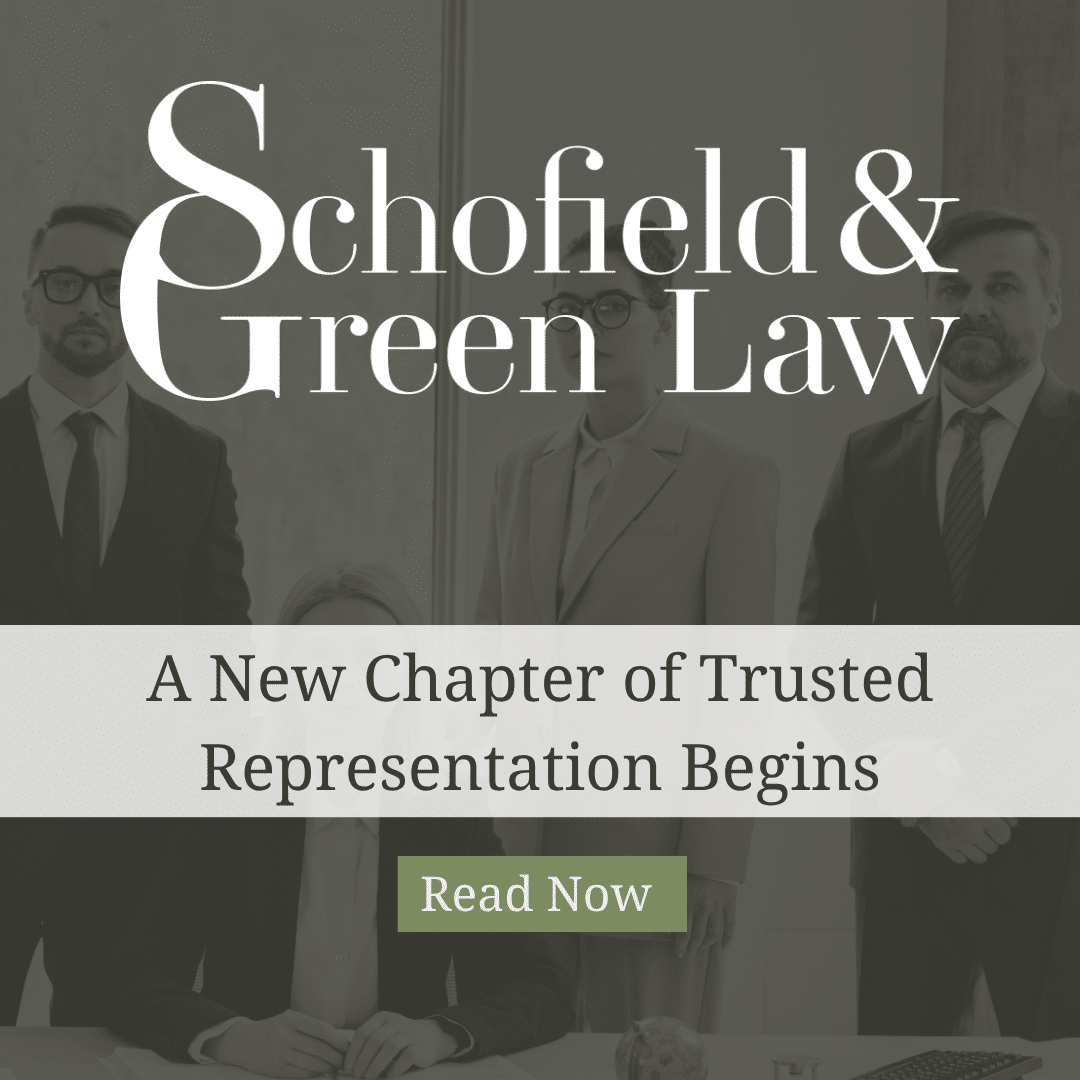In a successful civil lawsuit for a personal injury case, the injured party receives monetary compensation for the losses they have experienced due to the accident. These “damages” are collected from the liable party. But exactly what are damages? What are the different types of damages? And how much can a plaintiff collect? At Schofield & Green Law, we can help answer these questions and provide a greater understanding of personal injury damages. Understanding your personal injury case is paramount and a key to obtaining the compensation you deserve.

What Are Personal Injury Damages In A Lawsuit?
Damages refer to the total monetary compensation that the injured plaintiff receives to account for any losses they have experienced as a result of the accident. Whether someone has been injured and has medical bills, has experienced a loss of income, or has been emotionally and mentally impacted, damages aim to make the plaintiff “whole” again after an injury.
Types of Damages in Personal Injury Lawsuits
Damages are broken down into three general categories: economic, non-economic damages, and punitive damages.
1. Economic Damages (Special Damages)
Economic damages (also called special damages) compensate for measurable, out-of-pocket financial losses resulting from an injury or wrongful act. These damages can be proven with documentation like receipts, bills, pay stubs, or expert testimony.
- Medical bills: Reimbursement for all past, current, and reasonably anticipated future medical expenses related to the injury.
Example: Emergency room visits, surgeries, prescription medications, doctor appointments, hospital stays, imaging (X-rays, MRIs), or assistive devices like crutches or wheelchairs. - Lost income: Compensation for wages or income lost due to time off work from the injury, including future earning capacity if the injury affects long-term employment.
Example: If a construction worker is out for three months recovering from surgery, they may claim the wages they would have earned during that period. If the injury causes a permanent disability, future lost earnings may also be calculated and awarded. - Rehabilitation or physical therapy: Costs associated with recovery programs or physical therapy sessions needed to restore function or mobility.
Example: A person who suffered a back injury in a car accident may need 12 weeks of physical therapy sessions, chiropractic care, or occupational therapy to regain movement and independence. - Property damage: Reimbursement for the repair or replacement of property damaged during the incident.
Example: If someone’s vehicle is totaled in a car crash caused by another driver, the cost to repair or replace the vehicle is covered. This can also include damaged electronics, clothing, or other personal items. - Funeral costs: In wrongful death cases, the family may be reimbursed for funeral and burial expenses.
Example: If a loved one passes away due to a workplace accident, the responsible party may be ordered to pay for the casket, service, burial plot, and related funeral expenses. - Out-of-pocket expenses: Miscellaneous costs directly tied to the injury or incident that don’t fall under other categories.
Example: Transportation costs to and from doctor appointments, over-the-counter medical supplies, hotel stays for treatment in another city, or home modifications like installing a wheelchair ramp.
These damages are considered “economic” because they are objectively measurable, typically documented, and can be calculated down to the dollar.
2. Non-Economic Damages (General Damages)
Non-economic damages compensate victims for subjective, non-monetary losses resulting from an injury or wrongful death. While these damages don’t come with a receipt or price tag, they reflect the real and lasting impact the injury has on a person’s life and well-being.
These types of damages are harder to calculate and often require testimony from medical professionals, mental health experts, or close family and friends to illustrate the toll the incident has taken.
Non-economic damages include:
- Pain and suffering: Compensation for the physical pain and discomfort a person endures as a result of their injuries, including ongoing or chronic pain.
Example: A person who suffers a traumatic brain injury in a car accident may experience headaches, nerve pain, or mobility issues for the rest of their life, significantly affecting their quality of life. - Emotional distress: Mental anguish, anxiety, depression, post-traumatic stress disorder (PTSD), or other emotional or psychological effects caused by the incident.
Example: After a serious dog attack, a victim may experience PTSD, nightmares, and severe anxiety around animals—conditions that affect daily living and mental health. - Loss of enjoyment of life: Compensation for no longer being able to enjoy hobbies, activities, or day-to-day pleasures due to the injury.
Example: A retired teacher who loved gardening and hiking can no longer participate in those activities after a spinal injury, resulting in a diminished quality of life. - Loss of companionship or consortium: Compensation for the loss of a close relationship—such as emotional support, affection, or intimacy—often awarded to spouses or family members of the injured or deceased.
Example: A spouse may claim loss of consortium if their partner is paralyzed in an accident and the relationship suffers due to the inability to share affection, companionship, or a normal married life. - Disfigurement or permanent disability: Damages awarded for visible scarring, amputation, or long-term impairments that alter appearance or functionality, often tied to emotional trauma and social stigma.
Example: A burn victim may be awarded non-economic damages for the psychological toll of facial disfigurement and the social isolation that follows. - Grief and loss in wrongful death cases: In wrongful death lawsuits, surviving family members may be compensated for the deep sorrow and emotional pain caused by losing a loved one.
Example: The parents of a child killed in a pedestrian accident may receive damages for the emotional devastation and irreplaceable loss of that child’s companionship.
These damages aim to recognize that not all suffering is visible or financial—emotional injuries can be just as painful and life-altering. Though difficult to quantify, they are an essential part of making victims whole again after a serious injury or tragic loss.
3. Punitive Damages (Exemplary Damages)
Punitive damages are not meant to compensate the victim for losses—they are meant to punish the wrongdoer and deter others from engaging in similar behavior. These damages are awarded in addition to economic and non-economic damages, but only in cases involving egregious misconduct, such as fraud, gross negligence, or intentional harm.
Punitive damages send a clear message that certain behaviors—especially those showing a reckless disregard for the safety or rights of others—will not be tolerated.
Punitive damages may apply when the defendant’s actions involve:
- Gross negligence: Extreme carelessness that shows a blatant disregard for the safety of others, going far beyond ordinary negligence.
Example: A trucking company allows a driver with multiple DUIs and no valid license to continue operating 18-wheelers, resulting in a fatal crash. - Intentional misconduct: Harmful actions committed on purpose, rather than by accident or oversight.
Example: A caregiver physically assaults a nursing home resident. This kind of deliberate abuse can lead to punitive damages in addition to compensating the victim. - Fraud or deceit: Knowingly making false statements or concealing critical information that leads to someone’s harm.
Example: A pharmaceutical company hides known side effects of a drug that later causes serious health complications in patients. - Malice or evil intent: Conduct driven by spite, hatred, or intent to cause harm.
Example: A landlord deliberately cuts off heat to a tenant’s apartment in the middle of winter, hoping they’ll move out sooner. - Repeated or institutional misconduct: Cases where a business or organization has a history of bad behavior or fails to correct dangerous practices.
Example: An employer ignores multiple safety violations that have injured workers, and continues operations without fixing the issues.
Punitive damages are rare and typically only awarded when the court wants to make an example out of the defendant. Because of their severe nature, many states cap the amount that can be awarded, and courts may require clear and convincing evidence of misconduct.

Damages Caps
Typically, damage caps only apply to non-economic damages and only in special cases, for instance, medical malpractice. Because some states have implemented damage caps as part of tort reform efforts, it is especially important to understand the difference between economic and non-economic damages.
Contact Colorado Springs Personal Injury Attorneys
If you have been injured due to someone else’s negligence, you could be entitled to compensation. However, certain restrictions and time limitations may apply in certain situations. If you have been injured in an accident in Colorado Springs, contact the experienced Colorado Springs personal injury attorneys at the Schofield & Green Law Firm today to schedule a no-obligation consultation and discuss your case. Call us today at 719-694-8515.






